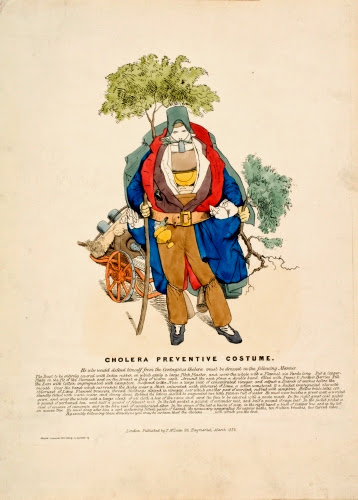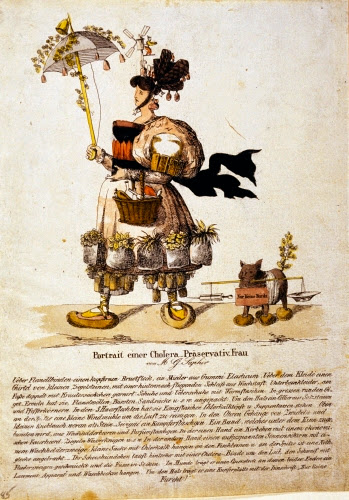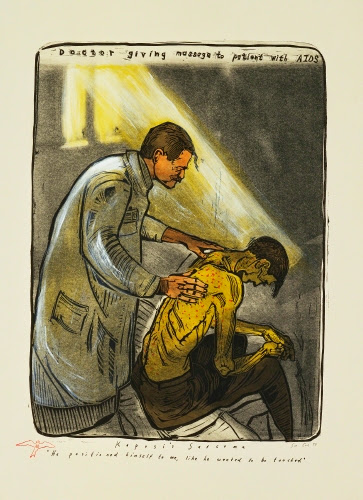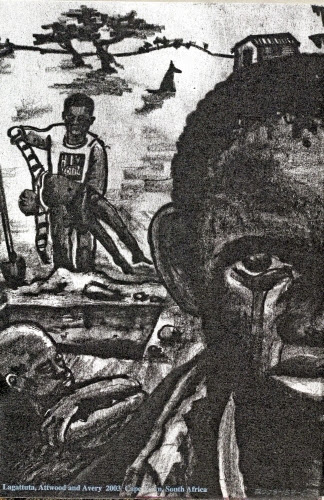An Epidemic Satirized in Art: Franz Dörbeck
With the current focus on the Ebola outbreak, let’s reflect on the many epidemics that caught the world’s attention in the 20th and 21st centuries: bird flu, SARS, swine flu, flesh-eating bacteria, and not to mention HIV are some that have garnered a lot of fear. Obviously, the 21st century is not the first time period in history to experience such outbreaks, in fact, things were much worse before the medical community understood the nature of viruses and bacteria, knowledge of which started in the mid-1800s. Also, in the 21st century, we do not tend to see art on a large scale that chronicles such epidemics, unless it is politically or socially oriented.
 |
| Franz Dörbeck (1799–1845, Germany), published by Thomas McLean (1788–1875, London), Cholera Preventive Costume, 1832. Hand-colored lithograph, 15" x 11" (38.1 x 27.8 cm). © Philadelphia Museum of Art. (PMA-4347) |
Cholera was one of the Ebola epidemics of the 1800s, as was Malaria and Yellow Fever. This was all before scientists such as Louis Pasteur, Joseph Lister, and John Snow discovered the existence of viruses and bacteria. Certain bacilli (bacteria) in drinking water is what caused the massive cholera outbreaks in the 1800s. It is thought to have originated in India, and migrated to Northern Europe and the US in the early 1800s because of the British Empire’s frequent trade with India. It assumed particularly dire outbreaks as early as 1830 in London. These outbreaks lasted until the end of the 1800s when improved public water treatment evolved. Cholera was also a problem in the US until the late 1800s when water treatment plants in major cities were improved.
This print reflects the then current assumption of the miasmatic transmission of the disease (air-borne basically). This idea was ages old, dating back to the Black Death (bubonic plague) of the late Roman Empire (ravaged the empire in the 400s and 500s ce), and of the 1300s (killed nearly a quarter of the population of western Europe). The idea that cholera was air borne was disproved starting in the 1850s when John Snow demonstrated that it was caused by contaminated drinking water. The print basically mocks the idea of herbs and breathing apparatus to ward off the disease.
Satirical prints, both politically and socially oriented, evolved in Britain during the 1700s, and reached particularly sophisticated levels after the 1810s. Rather than explaining people’s efforts to avoid cholera, these prints, like the one below, served to mock people who were superstitious about the spread of the contagion. I think it’s a great thing that doctors nowadays understand germs and contagious disease, even when they spread as Ebola has in western Africa. Here are the examples of preventive measures mocked in the above print:
- copper breast plate
- bag of sand
- band of pepper and juniper berries around the neck
- ear cotton with camphor
- vial of vinegar under the nose
- pound of coriander root
- juniper tree
- ten friction bushes in a cart
The print ends by saying: “By exactly following these directions you may be certain that the Cholera will attack you first.”
Here’s the female equivalent of the above print. I think the dog is really cute with his sprout of juniper for a tail.
 |
| Franz Dörbeck (1799–1845, Germany), Cholera Preservative Woman, ca. 1832. Color engraving, 27 x 23 cm (10 5/8 x 9”). © Philadelphia Museum of Art. (PMA-1562) |
Here are examples of artists’ reaction to contemporary epidemics:
 |
| Sue Coe (born 1951, US), Doctor Giving Massage to an AIDS Patient, from the New Provincetown Print Project portfolio, 1993. Linoleum cut and monotype with ink additions. The Museum of Modern Art, New York, © 2014 Sue Coe. (MOMA-P2562) |
 |
| Eric Avery (born 1948, US), Art for Medicine, a folded broadside, 2003. Offset lithograph, 11 x 7 ¼” (27.9 x 18.4 cm). Philadelphia Museum of Art, © 2014 Eric Avery. (PMA-3984B) |
Correlations to Davis programs: A Community Connection: 8.2, A Global Pursuit: 3.1, Experience Printmaking: 6, The Visual Experience 9.4


Comments